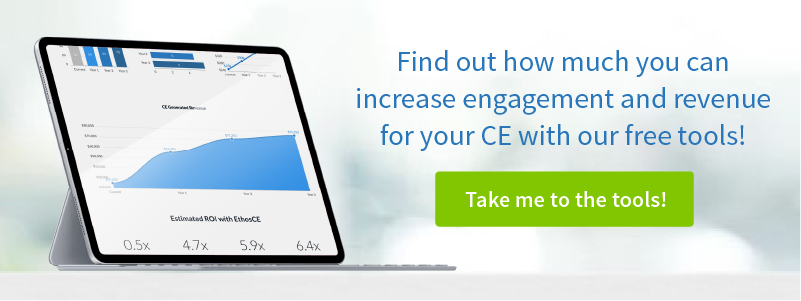Managing Continuing Education Engagement for Higher Completion
Maintaining learner engagement is essential to boosting course completion rates. This post will present several reasons why more efficient CME management process leads to better continuing education engagement, and by extension, higher numbers of students staying on track.
Why Learners Leave: The Importance of a User-Friendly LMS
Platform ease-of-use must be the first consideration when developing a plan to boost completion rates. That’s because any interruption in the learning experience—whether it is an input error that leads to an accidental logout or a difficult-to-navigate activity— can cause an unpleasant ripple effect. A learner may become frustrated with the platform, their engagement with the activity will be compromised and their knowledge retention will suffer. This leads to poor scores on assessments and in many cases, the student abandoning the activity.
So how do you know if your LMS is user-friendly? Even if you don’t have any specific learner feedback on your LMS website’s functioning and aren’t able to have a professional design firm complete a website usability test, you can still determine if you need to upgrade your platform.
Here are some questions to ask yourself:
- How long does it take to launch an activity after logging in? The transition from entering the website and relaunching an activity should be seamless. If users have to hunt to find their activity or return to where they left off during the last session, you’ll be adding to their frustration with every visit.
- Is it difficult to check activity progress? Confusion over activity status wastes the learner’s time and often leads to a support call (and more frustration). Users should be able to find out how far along they are in an activity within seconds after they log in.
- Do the LMS allow enough time for users to complete tasks? Learners should never feel as if they have to race against the clock to input information. Your LMS should allow you to easily adjust the time that users have to complete quizzes or other timed activities.
- Is it easy to access and use the activity’s audio or video components? When users have to leave the LMS to view or listen to a media file, the learning experience is no longer immersive—and engagement may suffer.
If your LMS doesn’t meet the above criteria, then you’ll need to address those issues—or switch to a new user-friendly CME LMS — before putting an engagement strategy into play.
Learning Experience Design Basics: How Learners Become Engaged and Inspired
Managing CME engagement effectively is a process that requires a deep level of understanding of how the structure of the learning experience impacts completion rates. Here are a few basic facts:
Students become engaged and stay that way when feedback during learning activities is consistent and constructive. A user who is struggling with an activity and receives a low score on a quiz shouldn’t be left with radio silence. An LMS with the ability to provide feedback—either globally or in response to specific answers given during an assessment—will keep inspiring both challenged and advanced learners to improve.
Another tactic to consider is content gamification. This isn’t (unfortunately) the same as adding a version of Candy Crush to a necessary, but less than thrilling segment of an activity. Gamification means adding elements that require sustained interactivity and which reinforce concepts using game-like features. For example, an activity employing gamification would include a series of quizzes that allow users to accumulate badges appear on a virtual scoreboard. Once a user passes a quiz, they would receive an email notifying them that they have achieved a new badge. According to recent research, game-based learning makes students feel more engaged with their material and aids knowledge retention. If your LMS has an integrated notification system and permits you to add custom quizzes, you’ll be able to add gamification to your user engagement strategy easily.
The intelligent use of rich media can transform learner engagement. You’ve probably heard or read that the use of video as a teaching tool is a great way to drive home even the most complex concepts. It is also a component that can be easily overused—becoming one more activity add-on that may distract more than it instructs. Use video sparingly to help learners through especially difficult topics, or to liven up sections which might be (just slightly) yawn-inducing. If your LMS allows it, embed your video along with a companion transcript for learners who might have issues with streaming videos or following audio.
Why Use an LMS Concierge Service to Manage CME Engagement
Engaged learners are more motivated to complete their courses. They put more effort into overcoming the obstacles to learning, and they find it easier to translate their knowledge into their professional practices. None of this can happen if staff resources—and the CE coordinator’s budget and time—are monopolized by operational and administrative issues which could be managed more easily through a CME business platform. When CE coordinators must constantly audit their LMS for ease-of-use bottlenecks while managing platform issues such as payments, support tickets, and registrations, they have less time to develop engaging, ACCME-compliant educational experiences.
For the past 16 years, EthosCE has helped associations develop long-term educational management strategies which promote learner engagement. Our feature-rich LMS platform provides you with all of the tools that you will need to manage curriculum development, data management, and other critical tasks such as PARS-compliant reporting and learner outcomes analysis. Take a look at our features and schedule a 1-on-1 with us today. Let us help you meet and exceed your CME goals.
 We're now part of the Cadmium product suite! Learn more
We're now part of the Cadmium product suite! Learn more 

